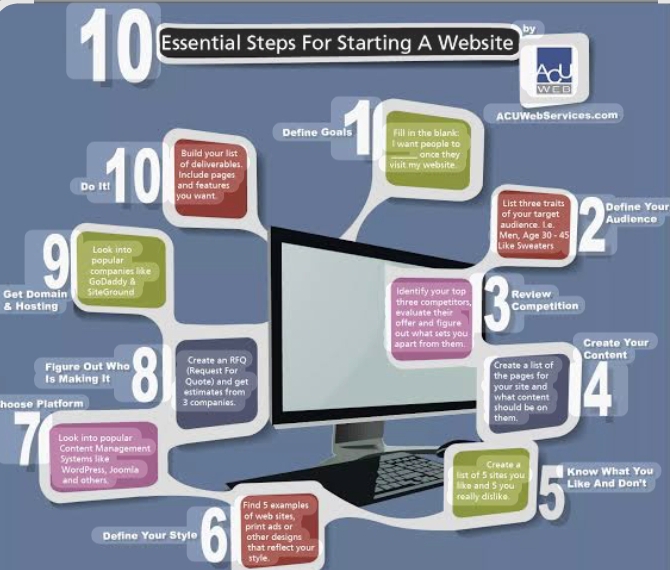
A Step-by-Step Guide to Building a Website
Building a website is an essential skill in today’s digital age. Whether you’re a business owner, a freelancer, or someone with a passion project, a well-designed website can help you establish an online presence and connect with your audience. In this guide, we’ll walk you through the process of creating a website from scratch, covering everything from planning to launch. Let’s get started!
—
Step 1: Define Your Purpose and Goals
Before you dive into designing or coding, it’s crucial to understand the purpose of your website. Ask yourself:
What is the primary goal of the website? (e.g., selling products, sharing information, or building a community)
Who is your target audience?
What key features and functionalities will you need?
Write down your answers and create a clear mission statement for your site. This will guide all your decisions moving forward.
—
Step 2: Choose a Domain Name and Hosting Provider
Domain Name
Your domain name is your website’s address on the internet (e.g., www.example.com). A good domain name should be:
- Memorable
- Relevant to your brand or purpose
- Easy to spell and pronounce
- Use domain registration platforms like GoDaddy, Namecheap, or Google Domains to check the availability of your desired name.
Hosting Provider
Web hosting is a service that stores your website’s files and makes them accessible online. Popular hosting providers include:
- Bluehost
- SiteGround
- HostGator
- AWS (Amazon Web Services)
Choose a hosting plan that fits your needs and budget. For beginners, shared hosting is a cost-effective option.
—
Step 3: Plan Your Website Structure
A well-organized website structure improves user experience and helps with search engine optimization (SEO). Create a sitemap that outlines your main pages and their subpages. Common website pages include:
- Homepage: The main entry point to your site
- About Us: Information about you or your business
- Services/Products: Details about what you offer
- Blog: A section for articles and updates
- Contact Us: Ways for visitors to get in touch
- Use tools like Google Drawings or free website wireframing tools to map out your structure.
—
Step 4: Choose a Website Building Platform
You don’t need to be a coding expert to create a website. Many user-friendly platforms allow you to build a site without technical skills. Some popular options are:
- WordPress: Flexible and customizable, suitable for all kinds of websites.
- Wix: Drag-and-drop interface, great for beginners.
- Squarespace: Stylish templates, ideal for portfolios and creative projects.
- Shopify: Best for e-commerce websites.
If you prefer more control and have coding experience, you can opt for custom development using HTML, CSS, and JavaScript.
—
Step 5: Design Your Website
Select a Template
Most website builders offer pre-designed templates. Choose one that aligns with your brand’s aesthetic and functionality needs. Ensure the template is:
- Responsive (adapts to different screen sizes)
- SEO-friendly
- Easy to customize
- Customize the Design
- Customize your chosen template to make it unique. Focus on:
- Branding: Use your brand colors, logo, and fonts.
- Navigation: Keep menus simple and intuitive.
- Images and Graphics: Use high-quality visuals that resonate with your audience.
- Tools like Canva can help you create graphics if you don’t have a design background.
—
Step 6: Add Content
Content is the heart of your website. Ensure it is engaging, informative, and aligned with your goals. Key types of content include:
- Text: Write clear and concise copy that speaks to your audience.
- Images: Use relevant, high-quality photos or illustrations.
- Videos: Incorporate videos to increase engagement.
- For written content, focus on:
- Headlines: Catchy and descriptive titles
- Body Text: Break up paragraphs for readability
- Call-to-Actions (CTAs): Encourage visitors to take specific actions (e.g., “Sign Up” or “Buy Now”)
—
Step 7: Optimize for Search Engines (SEO)
SEO helps your website rank higher in search engine results, making it easier for people to find you. Here’s how to optimize your site:
- Keywords: Research relevant keywords and incorporate them into your content.
- Meta Tags: Write compelling meta titles and descriptions for each page.
- Alt Text: Add descriptive alt text to images.
- Mobile-Friendly: Ensure your website looks great on mobile devices.
- Tools like Google Analytics and SEMrush can help you track and improve your SEO performance.
—
Step 8: Test Your Website
Before launching your site, thoroughly test it to ensure everything works smoothly. Check for:
- Broken links
- Spelling and grammar errors
- Page load speed
- Compatibility across different browsers (e.g., Chrome, Safari, Firefox) and devices
- Use tools like Google PageSpeed Insights and BrowserStack for testing.
—
Step 9: Launch Your Website
Once you’re satisfied with your website, it’s time to go live! Announce your launch through social media, email newsletters, and other marketing channels. Don’t forget to:
- Submit your site to search engines like Google for indexing.
- Set up analytics tools to monitor traffic and user behavior.
—
Step 10: Maintain and Update Your Website
A successful website requires regular maintenance. Keep it fresh and relevant by:
- Updating content and images
- Adding new features or pages
- Monitoring and fixing technical issues
- Schedule periodic reviews to ensure your site continues to meet your goals.
—
Conclusion
Building a website may seem daunting at first, but by following these steps, you can create a functional and attractive site that serves your needs. Remember, your website is a dynamic platform that can evolve with your goals and audience. Invest time in planning, designing, and maintaining it, and you’ll reap the rewards of a strong online presence.
Here’s the step-by-step guide to building a website. Let me know if you’d like any adjustments or additional details!
Leave a Reply